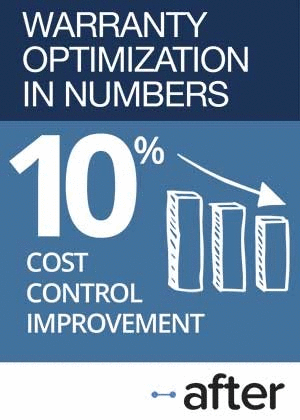Aerospace Warranty Report:
Because a few big manufacturers dominate the industry, their problems or successes with warranty cost control can change the industry averages significantly. But over the long term, the trend is clear: aerospace suppliers have learned how to cut their warranty expenses and keep them low. The OEMs? Not so much.
Even with a product that's meant to never fail, such as a commercial airliner, warranty costs are inevitable. And the handful of companies that make commercial airplanes, business jets, helicopters and their components have been spending well over a billion-and-a-half dollars on warranty claims each year since 2007.
It's not as much as the makers of trucks, cars, computers or smartphones are paying out in warranty costs, but it's a significant slice of the entire warranty pie. And ten of the largest aerospace manufacturers are among the largest warranty providers based in the entire U.S.
For this week's analysis, we took 100 companies with a significant presence in the aerospace industry and separated them into 10 makers of airframes and fuselages (which we're calling the OEMs), and 90 makers of avionics, jet engines, interiors, and other parts and components (which we're calling the suppliers).
United Technologies Corp., a diversified manufacturer with interests in the heating, air conditioning, and elevator industries in addition to its helicopters and jet engines, is counted here as a supplier. And being as all companies report just one set of warranty metrics for all their worldwide product sales, inevitably we're counting some Otis and Carrier warranty expenses here when they really shouldn't be included.
Likewise, some of the satellite manufacturers that are counted as telecommunications equipment suppliers in our industry categories are also included here (though Iridium Communications Inc. is the only one currently reporting warranty expenses). And both navigation equipment and drones have a consumer electronics component. Suffice it to say that this list of 100 aerospace companies is more inclusive than the one-industry-per-company tally used in the March 19 newsletter.
Warranty Claims Remain Steady
Let's start with product warranty claims payments. As can be seen in Figure 1, claims payments in the U.S.-based aerospace industry as a whole have been relatively stable for multiple years, compared to other industries. Between 2007 and 2014, the industry total has ranged from $1.53 billion in 2012 to $1.78 billion in 2008 and again in 2014 (actually, if we need a tiebreaker, the total in 2008 was $2 million higher). And there was no big decline.
Compared to the automotive industry that we profiled in last week's newsletter, there seems to have been very little damage left by the recent recession, at least with this warranty metric. And that's unexpected, because while there's no consumer aerospace industry (it's almost all business-to-business or business-to-government), one would expect there to have been a downturn in product sales, and therefore in warranty claims, to both businesses and governments, as the need for transportation vehicles declined.
That's what happened with trucking, which is another business-to-business and business-to-government segment of the transportation industry. Less boxes to ship means fewer trucks needed. And as the recession bit into taxes, better put off those municipal bus fleet replacements too. Less commerce needs fewer vehicles, at least with ground-based vehicles.
But none of that is in evidence in the aerospace industry. If anything, the growth in Boeing's claims was more or less met with the decline in United Technologies' claims, keeping the industry total level. Boeing's claims payments grew from $220 million in 2007 to $432 million last year, while UTC's claims payments fell from $531 million to $344 million over the same period.
Figure 1
Worldwide Warranty Claims
of U.S.-based Aerospace Companies
(claims paid in US$ millions, 2003-2014)

From 2013 to 2014, industry-wide claims grew by only $51 million. The aerospace OEMs paid out $38 million more in 2014 than they did in 2013, while their supplier paid out $13 million more. Within those categories, UTC was up by $57 million; Textron was up by $30 million; Boeing was up by $13 million; General Dynamics (Gulfstream) was down by $5 million; and Honeywell was down by $20 million.
Warranty Accruals Up Slightly
The story in aerospace warranty accruals is only slightly different. As can be seen in Figure 2 below, industry-wide accruals actually fell by $11 million from 2012 to 2013, but then grew by $91 million from 2013 to 2014. But that means three straight years of accrual totals either slightly above or slightly below $2 billion.
Figure 2
Worldwide Warranty Accruals
of U.S.-based Aerospace Companies
(accruals made in US$ millions, 2003-2014)

The aerospace OEMs increased their accruals by $24 million, while the suppliers increased their accruals by $67 million. With this warranty metric, the biggest upward moves came at Textron (+$35 million); UTC (+$24 million); General Dynamics (+$21 million); and Honeywell (+$13). The biggest accrual reduction came at Boeing (-$29 million).
Warranty accruals more generally follows sales trends, and indeed in the data above we see that 2009 and 2010 saw the lowest accrual totals of the last nine years. But the biggest change of all was the increase for Boeing in 2012, which we've previously blamed on the problems the company experienced with its newer aircraft, especially the 787 Dreamliner, which was actually grounded a little over two years ago.
Steady Climb in Warranty Reserves
We see the inevitable result of those extra accruals in Figure 3, which tracks the warranty reserve fund balance of all the aerospace companies from 2003 to 2014. Boeing's balance jumped from $1.05 billion in 2011 to $1.57 billion in 2012, and that helped drive up the industry total from $4.43 billion to $4.64 billion. By the end of 2014, the industry's total reserves had grown to $4.73 billion.
Figure 3
Worldwide Warranty Reserves
of U.S.-based Aerospace Companies
(reserves held in US$ millions, 2003-2014)

With this warranty metric, however, the OEMs and the suppliers went in different directions. The 10 aerospace OEMs saw their balances rise by $65 million, while the 90 suppliers saw their balances fall by $51 million, for a net industry-wide reserve fund balance increase of $14 million.
Within those categories, General Dynamics saw its balance rise by $72 million while Textron saw its balance rise by $58 million. But Rockwell Collins was down by $13 million; UTC was down by $47 million; and Boeing was down by $66 million.
Note that besides the addition of accruals made, and the subtraction of claims paid, the warranty reserve fund balance is also affected by other adjustments. For instance, Textron acquired Beechcraft Corp. in early 2014 and added $67 million to its warranty reserves as part of that transaction. But it also reduced its reserves by $20 million because of foreign currency fluctuations during the year. With $323 million in claims and $334 million in accruals, the net effect was to increase reserves from $223 million at the beginning of the year to $281 million at the end of the year.
Meanwhile, Boeing, Honeywell, and United Technologies took money out of their warranty reserves after concluding that their accruals in previous years were a bit excessive. Boeing took out $200 million; UTC took out $40 million; and Honeywell took out $34 million. That money goes right to the bottom line.
Other companies -- much smaller than these -- made relatively larger adjustments to their reserves, given their size. For example, Timken Co., which makes bearings and gearboxes for aircraft and other vehicles, took out only $1.4 million in 2014. But that was equal to a third of their warranty reserves, and was significantly more than they paid out in claims during the entire year.
Meanwhile, aviation security equipment maker American Science and Engineering Inc. took out only $42,000 during the fourth quarter. But that was almost a quarter of their September 30 reserve balance. And they've been making these downward changes of estimate every quarter since mid-2013. And that means they grossly overestimated the claims cost of their products when they were sold.
A couple of companies underestimated the actual cost of claims and had to correct for the shortfall. Is that worse than overestimating? It's a bit like predicting the weather. You predict a storm and it turns out to be sunny, so you look foolish holding an umbrella. But if you predict sunny and it pours, you end up soaking wet.
Product Sales Increases
The other metric that affects these totals and averages is of course product sales. If sales are increasing, then so will accruals, even if repair costs and failure rates remain the same. And in general, sales are up.
In 2014, the aerospace OEMs saw commercial sales rise by nearly 13%, while their suppliers saw a 4.2% increase. Among the top 10 aerospace warranty providers, eight saw sales rise while only Rockwell Collins and L-3 Communications saw sales fall. Notable sales increases included B/E Aerospace (+18%); Textron (+15%); and Boeing (+13%).
The reason we bring up sales changes is because it has a major effect on the next two warranty metrics: the claims rate and the accrual rate. We calculate these respective metrics by dividing claims by sales, and accruals by sales. So even if the size of the expense in dollars remains about the same, a big sales gain will drive down the percentages all by itself.
However, sales has a bigger effect on the claims rate than on the accrual rate, because a manufacturer may be paying claims on a product sold years ago, especially in the aerospace industry where warranty durations tend to be lengthy. In contrast, accruals are made at the time of sale, so if there are more sales there are more accruals, and the percentage rate remains the same.
Therefore, changes in the claims rate are more easily explained away by recessions, new product introductions, changes in the product mix, or the timing of supplier reimbursements. Accrual rates, in contrast, should not change unless there has been a fundamental change in the failure rate or the cost of repairs.
In Figure 4, we've taken the claims and accruals of the 10 aerospace OEMs and their commercial sales totals and tabulated a pair of percentage rates. Note that while in Figures 1 through 3 there are 12 annual totals, in Figure 4 there are 48 quarterly measurements. So there are 96 percentage rate measurements in total.
It's pretty obvious that the OEMs had relatively higher expense rates in 2003 and 2004, followed by seven years of relatively lower expense rates. And then from 2012 to 2014 they went up again.
Figure 4
All U.S.-based Aerospace OEMs
Average Warranty Claims & Accrual Rates
(as a % of product sales, 2003-2014)

Their average accrual rate hit a new record high in late 2012, while their claims rate rose in early 2013. This is the way it should work: a manufacturer sees the problem coming, sets aside money for it, then spends the money. In that case, the manufacturer was Boeing, which as we mentioned had problems with the 787 Dreamliner.
However, that problem was corrected, and Boeing's accruals began to decline. So it must be other manufacturers that are keeping the accrual rate high in 2013 and 2014. Meanwhile, since 2012 claims rose but sales rose faster, so the claims rate fell from its early 2013 peak.
We shouldn't make too much of this, however. Anything near one percent is relatively good, especially in a mechanical and metallic industry such as aerospace. Expense rates are much higher with trucks and cars, for instance. And because of the peculiar way warranty works in the aerospace industry, it's highly likely that a part is replaced before technicians are sure it has failed. And it's only later, after the jet has departed, that they figure out whether it's covered by warranty. And to make it even more peculiar, the technician is probably working for the customer, not the manufacturer or the seller.
Steady Cost-Cutting Record
Still, the long-term trend in Figure 4 is obvious. Rates were high, then they fell, but now they're rising again. It's even more apparent when we compare and contrast the pattern in Figure 4 above with the pattern in Figure 5 below, which is for the 90 suppliers.
Figure 5
All U.S.-based Aerospace Suppliers
Average Warranty Claims & Accrual Rates
(as a % of product sales, 2003-2014)

Except for some bumps along the way, the trend in this chart is very conclusively downwards. That means the aerospace suppliers are paying out a declining share of their revenue in warranty expenses, cutting the cost of warranty, and pleasing their investors.
While we could get away with dismissing the upward trend in Figure 4 as "not that much," the headline for Figure 5 would be more like "down by half." Back in 2003, their average expense rate was around 1.4%. By 2014 it was under 0.7%. That's significant.
Incredibly, only three aerospace companies made any of the Top 10 lists included in the March 12 newsletter: Textron, B/E Aerospace, and FMC Technologies Inc. Seven other large warranty providers in the aerospace industry (those who paid out more than $24 million in claims last year) were not up or down by enough to make a list.
Weighted Averages
However, small changes by big warranty providers can still have an impact. Just as the weight of Boeing's warranty problems helped drive up the industry averages on the OEM side, the counterweight of UTC's warranty cost-cutting has helped drive down the averages on the supplier side. In other words, because UTC accounts for 30% to 45% of the claims and accruals tabulated for all 90 aerospace suppliers, its very successful warranty cost reductions are making the other 89 suppliers look good. Conversely, because Boeing has historically accounted for between 40% and 60% of all the claims and accruals on the OEM side, its recent problems make all 10 OEMs look bad.
Ironically, UTC's accrual rate was actually up slightly in 2014, while its claims rate rose from 0.6% to 0.7%. And Boeing cut both its claims and accrual rates last year. In other words, these upward and downward trends are not entirely due to one giant company. But they do reflect a long-term tendency: the aerospace suppliers are better than the OEMs at cutting their warranty costs and keeping them low.









